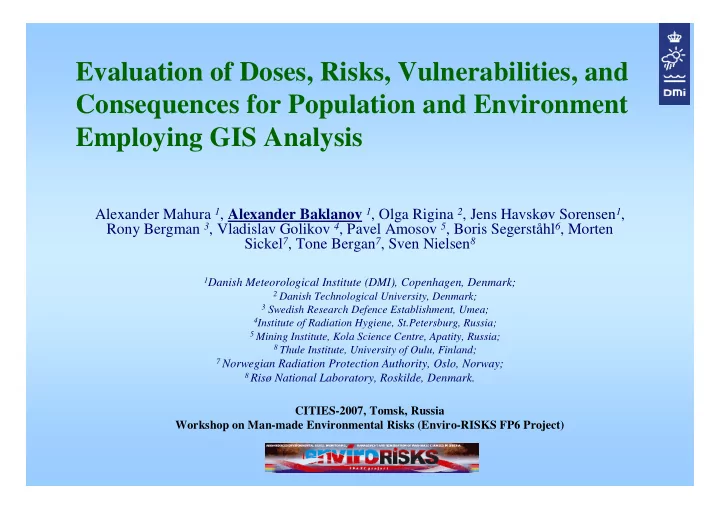

Evaluation of Doses, Risks, Vulnerabilities, and Consequences for Population and Environment Employing GIS Analysis Alexander Mahura 1 , Alexander Baklanov 1 , Olga Rigina 2 , Jens Havsk ø v Sorensen 1 , Rony Bergman 3 , Vladislav Golikov 4 , Pavel Amosov 5 , Boris Segerst å hl 6 , Morten Sickel 7 , Tone Bergan 7 , Sven Nielsen 8 1 Danish Meteorological Institute (DMI), Copenhagen, Denmark; 2 Danish Technological University, Denmark; 3 Swedish Research Defence Establishment, Umea; 4 Institute of Radiation Hygiene, St.Petersburg, Russia; 5 Mining Institute, Kola Science Centre, Apatity, Russia; 8 Thule Institute, University of Oulu, Finland; 7 Norwegian Radiation Protection Authority, Oslo, Norway; 8 Ris ø National Laboratory, Roskilde, Denmark. CITIES-2007, Tomsk, Russia Workshop on Man-made Environmental Risks (Enviro-RISKS FP6 Project)
Main Goals & Objectives Main Goals � Develop approaches for risk assessment and mapping based on multilevel GIS integration of the long- and short-term trajectory and dispersion modelling results; � Test on estimation of possible risks to environment and population in the Nordic countries considering long- and short-term emissions and long-term environment impact from large accidental sites, industrial complexes, metropolitan areas. Specific Objectives � Study possibilities of combination for approaches and tools used in probabilistic risk and cases studies analyses; � Integrate results of trajectory and dispersion modelling into multilevel risk assessment employing GIS technology; � Estimate doses/consequences/vulnerabilities and � Evaluate probabilistic risk for selected locations and areas resulted from radioactive and chemical pollution.
General Assessment Scheme Case Study Probabilistic Approach MODELLING MODELLING Approach LONG-TERM SHORT-TERM Trajectory Dispersion Dispersion Probabilistic Fields Indicators based on Indicators based on Trajectory Modelling Dispersion Modelling GIS Integration and Mapping of Modelling Results Databases: Calculation / Evaluation of Population, Land-use, Doses, Urban, Administrative, Risks, Social and Political Vulnerabilities, factors, etc. Consequences, Etc.
Probabilistic Indicators of Impact : Trajectory Modelling • Atmospheric Transport Pathways, • Airflow Probability Fields, • Fast Transport Probability Fields, • Typical Transport Time Fields, • Maximum Reaching Distance, • Maximum Possible Impact Zone, • Precipitation Factor /Relative Humidity Fields.
Probabilistic Indicators of Impact : Dispersion Modelling Kandalaksha: Aluminum Plant
� � � Tools and Approaches for Dose Calculation : TOOLS/ MODELS ECOMARC - Radioecological Model - ECOlogy Modeling in ARCtic, MACCS - MELCOR A ccident C onsequence C ode S ystem, UNSCEAR - Methodology of United Nations Scientific Committee on Effects of Atomic Radiation, COSYMA - COde SYstem from MAria (Methods for Assessing the Radiological Impact of Accidents). APPROACHES Selection of Nuclear Risk Sites and Accidental Releases, Identification of Source Term and Considered Radionuclides of Key Importance, Calculation of Doses due to: Inhalation, External Exposure from the Contaminated Cloud and Contaminated Surface, + Correction to Doses due to External Exposure (due to daughter products Ingestion .
GIS Integration of Dispersion Modelling and Dose Calculation Results : • Input available GIS databases, layers, shapes, etc. • Urbanized vs. rural areas, population, etc. • Land use categories, crops, soils and its properties, etc. • From short- and long-term dispersion and trajectory modelling results: such as airflow, time integrated air Source : concentration and depositions; • Ignalina Nuclear Power Plant – INP (Lithuania) • Evaluation by countries, counties, Radionuclide: locations, locations, etc. • Cs-137
GIS: Integration of Dispersion Modelling Results Ignalina Nuclear Power Plant (Lithuania), Cs-137
GIS: Dose due to Inhalation and Ingestion Ignalina Nuclear Power Plant (Lithuania), Cs-137
GIS: Doses Individual and Collective Ignalina Nuclear Power Plant (Lithuania), Cs-137
GIS: Collective Dose - Seasonal Variability Ignalina Nuclear Power Plant (Lithuania), Cs-137
GIS : Probabilistic Risk Mapping • Social Geophysical Factors : proximity to risk sites, population density, critical groups, ecological vulnerability, risk perception, preparedness of safety measures, economical and technical means, etc; • Probabilities : of accidents at risk sites, atmospheric transport toward the area of interest, precipitation and deposition over the area of interest, etc. For Scandinavian countries’ population (Kola NPP)
Conclusions • Evaluated and tested approaches and tools for probabilistic estimation of the atmospheric transport, dispersion, deposition, consequences and risks of pollution from selected nuclear and chemical risk sites/areas. • Tested integration of the trajectory and dispersion modelling results employing GIS technology. • Calculated, estimated and mapped the doses due to inhalation, from contaminated cloud and surface, and ingestion as well as regional vulnerability and probabilistic risk for population and environment (on examples). Applicability • Improvement of emergency response systems and decision support measures to harmful releases from potential risk locations; • Input for social and economical consequences studies of impact for population and environment of the neighboring countries; • Multidisciplinary risk and vulnerability analysis, probabilistic assessment of consequences of pollutants from existing sources on meso-, regional-, and long-range transport scales;
Acknowledgments Computer facilities & data archives This work was in part supported by High Performance Computing (HPC) grants of the Danish Meteorological Institute (+use of NEC-SX6 supercomputing facilities) and National Center for Atmospheric Research (NCAR, Boulder, USA) Collaboration, computer assistance, & advice stuff of the DMI Computer Services & NCAR Scientific Computing Division (NCAR) Financial support Nordic Arctic Research Programme (NARP) & Nordisk Forskerutdannings Akademi (NorFA)
Recommend
More recommend